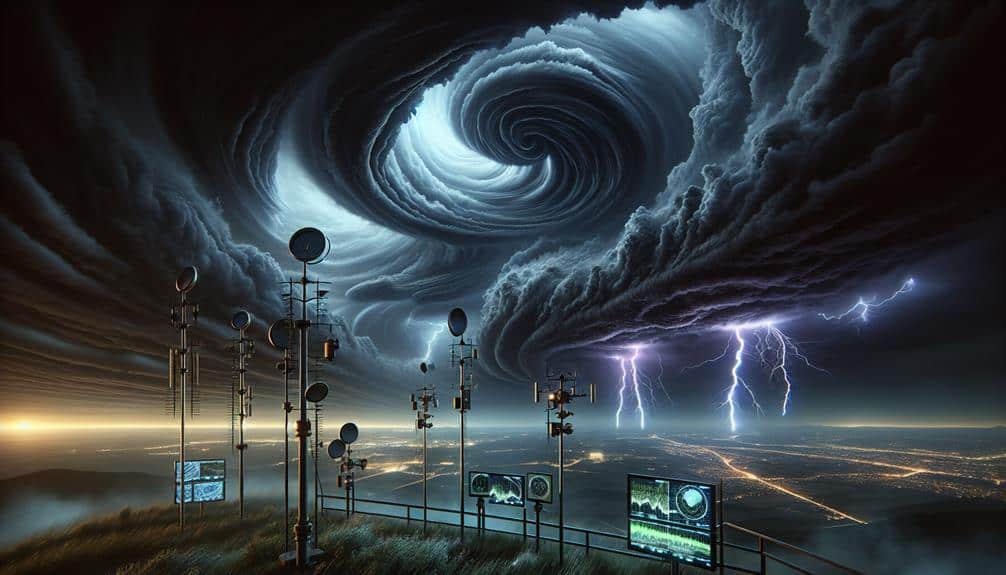We analyze storm formation by examining atmospheric pressure systems, temperature variations, humidity levels, wind patterns, and cloud formation processes. High and low-pressure areas interact to drive airflow and influence wind speed and direction, while temperature variations cause pressure changes and trigger convection currents. Humidity and moisture levels provide the necessary conditions for cloud and storm development. Jet streams and wind patterns steer weather systems, and converging winds create low-pressure zones ideal for storms. Using high-resolution satellite imagery and machine learning algorithms, we increase predictive accuracy. Explore further to understand the mechanisms behind accurate storm forecasts.
Key Points
- Atmospheric pressure systems influence wind patterns and storm formation by driving airflow and creating low-pressure zones.
- Temperature variations trigger convection currents and influence pressure changes, crucial for storm development.
- Humidity levels and moisture content play vital roles in cloud formation and precipitation, preceding storm events.
- Jet streams and wind patterns steer weather systems and impact the formation and intensity of storms.
Atmospheric Pressure Systems
Atmospheric pressure systems are fundamental to storm formation. They involve the movement and interaction of high and low-pressure areas in the Earth's atmosphere. When we examine these systems, we're looking at how pressure gradients drive airflow from high-pressure zones to low-pressure zones. These gradients are critical in determining wind speed and direction, both of which are key components in storm development.
Frontal boundaries, where two different air masses meet, are hotspots for storm activity. This is because the contrasting air masses often create significant pressure differences. When a cold front pushes under a warm front, the warm air is forced to rise rapidly. This upward movement can lead to cloud formation and, ultimately, precipitation.
On the flip side, when a warm front slides over a cold front, it can result in prolonged periods of rain and stormy conditions.
Role of Temperature Variations
We must examine how temperature variations directly impact storm formation by influencing surface temperatures, which in turn affect atmospheric pressure changes.
Our data indicates that differential heating results in significant shifts in heat energy distribution, creating the necessary conditions for storm development.
Surface Temperature Influence
Understanding how variations in surface temperature drive storm formation is essential for accurate weather prediction. When we look at temperature gradients, we recognize their pivotal role in storm development. These gradients, or differences in temperature over a specific distance, can lead to significant changes in surface conditions, which in turn influence weather patterns.
In analyzing the influence of surface temperature, we can break it down into several key factors:
- Heat Distribution: Uneven heating of the Earth's surface creates areas of high and low pressure, which can trigger convection currents.
- Moisture Availability: Warmer surfaces enhance evaporation rates, leading to increased humidity. This moisture is a vital ingredient for storm formation.
- Boundary Layers: Temperature variations between land and sea, known as thermal boundaries, often act as focal points for storm development.
- Energy Exchange: The transfer of heat between the surface and the atmosphere fuels storms, especially in regions where rapid cooling occurs at night.
Atmospheric Pressure Changes
Driven by temperature variations, changes in atmospheric pressure play an important role in storm formation, influencing wind patterns and the movement of air masses. When we examine the dynamics of pressure gradients, we see that they're directly linked to temperature differences across regions.
Warmer air, being less dense, rises and creates low-pressure zones, while cooler, denser air sinks, forming high-pressure areas. This vertical movement of air is essential for the development of storms.
To predict storms with greater accuracy, we rely on sophisticated pressure sensors. These devices measure minute fluctuations in atmospheric pressure, allowing us to map pressure gradients with high precision. By analyzing these gradients, we can predict the movement of air masses and the potential for storm development.
For instance, a steep pressure gradient often indicates strong winds, which can be a precursor to severe weather events.
Our improved understanding and technology enhance forecasting accuracy, empowering us to prepare and respond more effectively to potential storms. Accurate pressure readings help us understand the vertical movement of air, a critical factor in storm formation.
Heat Energy Distribution
Analyzing the distribution of heat energy across various atmospheric layers reveals how temperature variations impact storm dynamics and intensity. It's well-established that energy transfer is fundamental to storm formation.
As warm air rises, it creates areas of low pressure, drawing cooler air in from surrounding regions. These temperature gradients are essential in understanding how storms evolve.
Key factors in heat energy distribution include:
- Solar Radiation Absorption: Different surfaces absorb solar energy at varying rates. Oceans, for example, retain and release heat more slowly than land, creating significant temperature gradients.
- Latitudinal Energy Transfer: The Earth's rotation and tilt cause uneven solar heating, leading to thermal imbalances. Warm equatorial air moves toward the poles, while cooler air moves toward the equator, driving atmospheric circulation patterns.
- Vertical Heat Exchange: Convection currents transfer heat from the Earth's surface to higher atmospheric layers. This vertical movement influences cloud formation and precipitation intensity.
- Latent Heat Release: During condensation, latent heat is released, fueling storm systems. This process is particularly visible in tropical cyclones, where immense energy transfer occurs, intensifying the storm.
Humidity and Moisture Levels

Humidity and moisture levels play an important role in storm formation by providing the necessary water vapor that fuels convection and cloud development. When we analyze moisture patterns and humidity variations, we're essentially mapping the distribution of water vapor in the atmosphere. This data is essential for understanding where and when storms are likely to form. By tracking these patterns, we can identify regions with high moisture content, which are prime candidates for storm development.
The dew point, a key metric in our analysis, indicates the temperature at which air becomes saturated and moisture begins to condense. A higher dew point corresponds to greater moisture content in the air, signaling a higher potential for storm activity. By monitoring dew points, we can predict the likelihood of storm formation with greater accuracy.
Our analytical insights show that sudden changes in humidity levels often precede storm formation. For instance, a rapid increase in moisture content can lead to the rapid development of cumulonimbus clouds, the harbingers of thunderstorms. Understanding these dynamics empowers us to make more precise predictions, ultimately giving people the freedom to prepare and respond effectively to impending storms.
Wind Patterns and Jet Streams
Wind patterns and jet streams play an essential role in storm formation by influencing the movement of air masses and the distribution of atmospheric pressure. High altitude winds, especially the jet streams, are streams of fast-moving air that flow west to east and greatly impact weather systems. By understanding jet stream dynamics, we can predict how these high-speed winds will interact with atmospheric circulation to create conditions ripe for storm development.
Let's break down the key points:
- Jet Stream Dynamics: These narrow bands of strong winds are found at altitudes between 8 and 15 kilometers. They act like guides, steering weather systems and influencing the formation and path of storms.
- Wind Patterns: Surface and high altitude wind patterns determine how air masses converge or diverge, affecting pressure systems. Converging winds can lead to low-pressure zones, conducive to storm formation.
- Atmospheric Circulation: The movement of air in large-scale patterns around the globe helps distribute heat and moisture, vital components for storm development.
- High Altitude Winds: These winds can either amplify or weaken storm systems depending on their direction and speed, playing an essential role in the intensity and duration of storms.
Cloud Formation Processes

Let's examine how water vapor dynamics and atmospheric pressure changes facilitate cloud formation.
As water vapor ascends, it cools and condenses around aerosols, forming cloud droplets.
When atmospheric pressure drops, this process accelerates, enhancing cloud density and increasing the likelihood of storm development.
Water Vapor Dynamics
Understanding the role of water vapor dynamics is essential for accurately predicting cloud formation processes in storm systems. When we analyze condensation patterns, we can better understand how water vapor changes into liquid droplets, forming clouds. This shift is critical for storm development and precipitation dynamics. Specifically, the process involves the cooling of air to its dew point, which leads to the formation of clouds and, eventually, precipitation.
To break it down, here are four key elements to ponder:
- Humidity Levels: Higher humidity increases the likelihood of cloud formation as more water vapor is available.
- Temperature Variations: Rapid temperature drops can accelerate condensation, leading to more robust cloud formation.
- Aerosols and Particulates: These act as nuclei for condensation, aiding in the shift of water vapor to liquid droplets.
- Vertical Air Movement: Updrafts can carry moist air upwards, where it cools and condenses, forming clouds.
Atmospheric Pressure Changes
In examining atmospheric pressure changes, we find that shifts in pressure directly influence cloud formation processes by affecting air density and vertical movement. When a pressure gradient forms, it creates a force that drives air masses to move from high to low-pressure areas. This movement is fundamental to the formation of clouds and, subsequently, storm systems.
When air masses converge in low-pressure zones, they rise due to the lower density of the surrounding air. As these air masses ascend, they cool adiabatically—a process in which the temperature of an air parcel decreases without losing or gaining heat from its surroundings. This cooling leads to the condensation of water vapor, creating cloud droplets. Consequently, the intensity of the pressure gradient directly correlates with the rate of vertical air movement and cloud formation efficiency.
Our understanding of these processes allows us to predict storm formation with greater accuracy. By analyzing data such as pressure gradients, we can anticipate the behavior of air masses and the likely development of storm clouds. This knowledge empowers us to make informed decisions and maintain our autonomy in the face of nature's unpredictability.
Understanding atmospheric pressure changes is essential for accurate storm prediction and enhancing our freedom through better preparedness.
Advanced Predictive Technologies
Recent advancements in machine learning algorithms have greatly enhanced our ability to predict storm formations with improved precision. By leveraging these sophisticated algorithms, we've ushered in a new era of weather forecasting that's both more exact and reliable.
Machine learning allows us to analyze vast amounts of satellite imagery, identifying patterns and anomalies that traditional methods might overlook. Predictive modeling, powered by these algorithms, can quickly process data to forecast potential storm formations and trajectories.
Our approach incorporates several advanced technologies:
- High-Resolution Satellite Imagery: By utilizing satellites that capture detailed images of the Earth's atmosphere, we gain essential insights into storm development.
- Machine Learning Algorithms: These algorithms analyze data from various sources, learning from past patterns to enhance future predictions.
- Predictive Modeling: By simulating different scenarios, our models can provide precise forecasts and early warnings, giving people more time to prepare.
- Real-Time Data Integration: Combining data from multiple sources in real-time guarantees that our predictions are as current and precise as possible.
These technologies not only enhance our understanding of storm dynamics but also empower us to make informed decisions, safeguarding lives and property.
In a world where freedom to move and plan is vital, advanced predictive technologies are indispensable.
Frequently Asked Questions
How Do Solar Flares Affect Storm Formation Predictions?
We analyze solar flares to understand their impact on atmospheric dynamics. They can alter ionospheric conditions, influencing storm formation predictions. By integrating solar activity data, we refine our models, ensuring accurate and reliable forecasts for enhanced freedom.
What Role Do Ocean Currents Play in Storm Development?
Ocean currents and temperature greatly influence storm development. Warm currents elevate ocean temperature, boosting storm intensity. Accurate tracking of these currents allows us to predict storm paths and intensities more precisely, empowering us to prepare effectively.
Can Volcanic Eruptions Influence Storm Patterns?
Volcanic eruptions, like a giant sneeze, alter atmospheric conditions, affecting storm patterns. Volcanic activity releases particles that can change weather dynamics, leading us to examine data on how these eruptions influence atmospheric instability and storm development.
How Does Urbanization Impact Local Storm Predictions?
We analyze how urbanization impacts local storm predictions by examining urban heat islands. These areas alter atmospheric conditions, complicating weather forecasting. Urbanization's effects on storm behavior require precise data for accurate, timely predictions.
Are There Historical Trends in Storm Formation That Aid Prediction?
Let's connect the dots in the stormy tapestry of history. We've found that historical trends, influenced by climate change and atmospheric conditions, provide valuable data that help us predict storms more accurately, empowering our communities to prepare.


